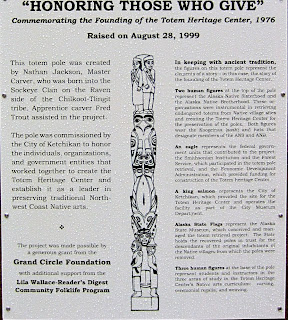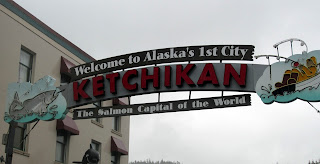I AM ON VACATION! The
mantra continues. The ship docked in Ketchikan at a little after 7 a.m. We were at sea yesterday, and the weather was lovely. Today would be different.
The town looks very quaint from the dock. After about 3 blocks in, it became hilly. It is
long along the coastline and narrow otherwise.
I went into town at about 9, wearing my green poncho as
there was a steady rain. The ship
docked right in the center of the western part of town.
After stopping at the information center when
I got a walking tour fold out map, I found where to get the free shuttle up to
the hatchery and eagle center and the totem heritage center. I had printed out a similar map off of the
website for Ketchikan. Ten minutes
later, I got off the shuttle and for $15, got into the two centers.
 |
| Ourside the Totem Museum |
 |

Above: Totem created for the creation of this center.
When I walked in, I faced 3 huge totems.
Totem poles honor the dead, record history and oral tradition. They were never worshiped. Once raised, they were left to deteriorate naturally. The western red cedar were often used to make poles as they withstood the damp climate quite well. The above examples were carved in the mid- to late-19th century. They were brought to Totem Heritage Center in 1976 to provide examples of traditional carvings and to inspire future carvers.
This is a close up of pole #3 above. After missionaries came to the area, people used to make poles that honored the dead. The top figure on this pole is brown bear, with wide nostrils, strong teeth, and sharp claws.
 |
| Tlignet in traditional regalia |
During the Depression, carvers at Saxman Village kept the art of carving going.
In the above photo taken at Saxman Village in 1941, a group of Native carvers work on the Wandering Raven pole, which now stands in the entrance to the Clan House in Totem Bight park. This was one of many totem poles carved as part of a Civilian Conservation Corps project in the late 1930s and early 1940s.
The following describes some of the reasons of totem poles were carved historically:
Above is a picture of Chief Johnson's house and totem pole in 1904.Above is the interior of Chief Lots' house in 1898.
Head of an old pole lying sideways in the museum.
The Raven figure above originally topped a 50-foot pole that stood in the center of a village. There are elements of a frog crest on the raven's breast and the tail may represent a sea mammal. You can see the original pole above in black and white.
Totem poles often had rings on them. They symbolize the number of generations an object or story has been owned by a particular group.
Poles were often used as supports for homes. Here is one that looks like an inverted eagle's claw. It is one of four that supported the main beams in a house in Old Kasaan.
There were also masks on display, made by instructors in the Totem Heritage Center carving classes.
Masks served a number of functions. The animals, humans, and mythical figures they depict may represent important events or feats or symbolize stories of clans or individuals. During special occasions, the masks are brought out and the stories are repeated so that they will be passed on. In some places, masks are made for a specific event and they thrown away.
I then went to the bird sanctuary and fish hatchery.
From 1917 to 1953, there was a bounty on bald eagles as the fish farmers through the eagles were raiding fish from their ponds. Eventually, they found out that was not true, but a # of eagles had already been killed. Juneau has a raptor recovery center. If an eagle loses a feather on one wing, one on the other side automatically falls off.
The sanctuary has an owl and 3 eagles that cannot be released in the wild. There are a number of such sanctuaries throughout Alaska. Two of the eagles cannot fly at all so we could see them. Auroro, the eagle on the left below, was found on a garbage dump with her left wing badly broken. She weighs ten lb. Cha-ak on the right hit a power line in Anchorage.She weighs 13 pl. These birds are powerful and can exert 1000 lb. of pressure per talon. Bald Eagles have a wing span of 6 to 8 feet.
The 2 eagles built the next above with twigs supplied by the staff. The grey horned owl was shot by a hunter. It has shrapnel in its right wing. The owls are the least intelligent of girls of prey as their eyes take up 90% of their brains. These eagles lay 2 to 3 eggs in the beginning of May and sit on them for about 30 days, which is the usual incubation period. Then the staff take away the eggs.
Eagles have amazing eyesight but have to rotate their head to see to the sides.
We then saw the fish hatchery and heard about the different kinds of salmon.
Later I learned the names of the 5 kinds through a finger association:
Thumb = Chum
Point (to eye) = Sockeye
Tall finger = King
Ring Finger = Silver
Pinky = Pink
The salmon imprint on the water in Ketchikan creek so return to the hatchery. From 30 they take the eggs and use them for the new spawning. Below you can see the development of the eggs. They are 6 months in incubators and are these coho and king salmon are released into the creek when the salmon are a year and a half old.
The rest they release back into the stream to lay their eggs naturally. They give the 30 mentioned above to low-income area people or feed them to their birds.
I then went to the bird sanctuary and fish hatchery.
From 1917 to 1953, there was a bounty on bald eagles as the fish farmers through the eagles were raiding fish from their ponds. Eventually, they found out that was not true, but a # of eagles had already been killed. Juneau has a raptor recovery center. If an eagle loses a feather on one wing, one on the other side automatically falls off.
The sanctuary has an owl and 3 eagles that cannot be released in the wild. There are a number of such sanctuaries throughout Alaska. Two of the eagles cannot fly at all so we could see them. Auroro, the eagle on the left below, was found on a garbage dump with her left wing badly broken. She weighs ten lb. Cha-ak on the right hit a power line in Anchorage.She weighs 13 pl. These birds are powerful and can exert 1000 lb. of pressure per talon. Bald Eagles have a wing span of 6 to 8 feet.
Eagles have amazing eyesight but have to rotate their head to see to the sides.
We then saw the fish hatchery and heard about the different kinds of salmon.
Later I learned the names of the 5 kinds through a finger association:
Thumb = Chum
Point (to eye) = Sockeye
Tall finger = King
Ring Finger = Silver
Pinky = Pink
The salmon imprint on the water in Ketchikan creek so return to the hatchery. From 30 they take the eggs and use them for the new spawning. Below you can see the development of the eggs. They are 6 months in incubators and are these coho and king salmon are released into the creek when the salmon are a year and a half old.
The rest they release back into the stream to lay their eggs naturally. They give the 30 mentioned above to low-income area people or feed them to their birds.
I then walked down the Creek Street boardwalk.
It paralleled Ketchikan Creek and had stunning views as I walked along. I took off my cape hat briefly for this picture even though it was still raining fairly hard..
I saw a number of beautiful (big) rhododendron plants along the way, about 6 or 7 weeks after these plants flowered in Seattle.
Many of the houses along the creek had been bordellos and bars when the logging and mining industries boomed but since then (esp in the past 20+ years) most have become businesses, art shops, or (especially) tourist places.
I stopped at the Star house, also called Dolly’s house. It is a slightly upscale tourist place with the original star in the floor still preserved.
It paralleled Ketchikan Creek and had stunning views as I walked along. I took off my cape hat briefly for this picture even though it was still raining fairly hard..
I saw a number of beautiful (big) rhododendron plants along the way, about 6 or 7 weeks after these plants flowered in Seattle.
Many of the houses along the creek had been bordellos and bars when the logging and mining industries boomed but since then (esp in the past 20+ years) most have become businesses, art shops, or (especially) tourist places.
I stopped at the Star house, also called Dolly’s house. It is a slightly upscale tourist place with the original star in the floor still preserved.
Part two of Ketchikan will follow with a description of the town museum, library, and Totem Bight state park, where I saw a lot of totem poles.




























No comments:
Post a Comment